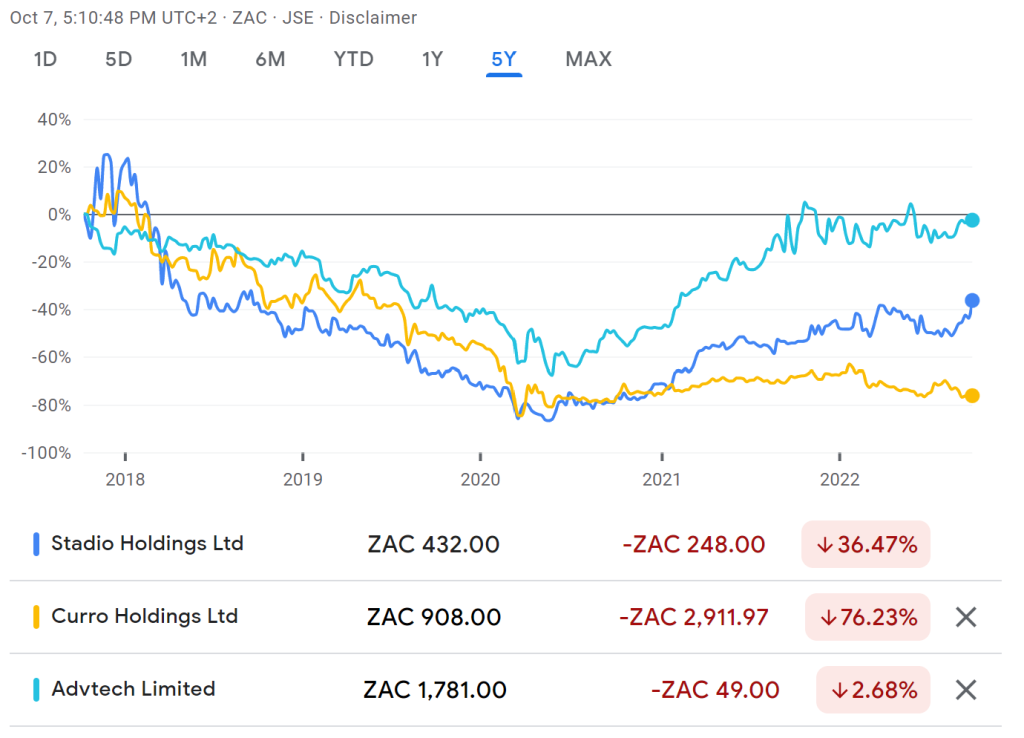Education is big business and there are three major listed education groups on the JSE. Ghost Grads Kayla Soni and Kreeti Panday are here to make it easier for you to learn about Curro, ADvTECH and Stadio.
The education groups are fascinating, even though they haven’t been great long-term investments. They are perfect examples of the importance of valuation multiples, as logic would certainly dictate that these companies should generate strong returns in South Africa.
Let’s start with Curro, the poster child for a growth story that the market got WAY too excited about.
Curro: a rare AltX success story that has had tough times
Curro was formed in 1988 and listed on the JSE (AltX) in 2011, moving to the JSE main board in 2012. Not only is this a rare example of a company that managed to grow beyond the AltX, but in 2017 it gave us another listed company: Stadio.
The PSG Group has a history of incubating and unbundling businesses, with the final step in that dance recently taking place with the unbundling of (almost) all of its assets and the removal of the listed structure.
Let’s not get distracted here, as PSG is a topic all on its own.
Curro deserves to stand on its own feet, operating more than 180 schools across 77 campuses. Even at this scale, Curro was far from immune to the impact of the pandemic. Ancillary income took a significant knock, as extramural activities were shut down.
With that base effect in mind, take note that revenue for the 6 months ended June 2022 rose by 15% to almost R2.1 billion. This has been attributed to learner growth (average numbers up 7% to just over 70,500) as well as fee increases. Recurring HEPS (which excludes R25 million once-off income) rose by 42% to 27.5 cents.
Clearly, the end of Covid-19 restrictions was great news for Curro, as the school once more has numerous ways to take parents’ money besides academics. A key driver of revenue growth was ancillary income from sources such as bus income, aftercare fees and boarding school fees, which saw an increase of 21% from the comparable period.
Importantly, gross receivables are lower and the loss provision looks a lot better, so parents are in a better position to pay the fees that are due.
Interestingly, the increase in ancillary income trails the increase in learner growth. There was a 25% increase in average learners from the first half of 2019 (pre-Covid) to the first half of 2022, yet only a 13.7% increase in ancillary income over this period. Unless you think that the school system has changed forever for some reason, this implies that there is runway for more revenue growth in this regard.
The ancillary income also comes at a cost, though. Extramural activities are back, which is partly why operating costs increased by 14.2%. Another driver of cost growth was investment in digital and vocational programmes. Staff costs increased by 11%, with more staff required to support learner numbers and a March salary increase of approximately 5%.
The investment thesis for Curro rests on the operating leverage that is inherent in the business model. Once the schools are built, the marginal cost of adding another student is relatively low, so the primary goal is to increase capacity utilisation of current facilities.
This doesn’t mean that Curro isn’t growing the footprint, mind you. Recent acquisitions include HeronBridge College and a new building for DigiEd Foreshore.
ADvTECH on the up and up
ADvTECH, owner of brands such as Crawford International, Trinityhouse, Abbott’s College and Pinnacle College, was founded in 1978 and today operates over 100 schools across Africa and over 30 tertiary institutions.
This is the first major difference to Curro: ADvTECH has a tertiary business in the same group as the primary and secondary schools.
The group also recently released results for the six months ended June 2022, landing on its feet post-Covid. Group revenue was up 18% and operating profit increased by 19%. At the bottom of the income statement, HEPS increased by 23%.
Gross trade receivables rose by 5% to over R750 million. Credit losses increased by 41.8% to over R110 million despite the provision as a % of receivables dropping, which suggests a significant number of write-offs in this period. Perhaps these were legacy debtors from the pandemic?
The group has focused its capital expenditure on increasing capacity to meet demand. This includes R98.5 million on additions to existing sites, a new school and one new tertiary site. The group expects to reach between R600 and R700 million on capital expenditure by the end of the year.
In schools specifically, revenue rose by 27% and operating profit increased by 70%.
In the group’s tertiary division, including Varsity College, Rosebank College and MSA, revenue grew by 9% and operating profit by 13%. The group has highlighted an advantage in its multi-channel modes of delivery, offering on-campus, blended and online learning options.
In the group’s interim results presentation, ADvTECH emphasised the roles of a weakening public education system and a fall in university subsidies in boosting demand for private education in South Africa. The group noted the difference between matric pass rates in 2021 of 76% for DBE students, 98.4% for IEB students and 98.3% for ADvTECH IEB students.
This positive sentiment towards private schools is reflected in ADvTECH’s enrolments. From February 2021 to February 2022, the group’s school enrolments increased by 9% to 36 802 and full qualification tertiary enrolments rose by 4% to 47 539.
Stadio’s successful streak
If you were wondering where Curro’s tertiary business went, you’re about to find out. If you combine Stadio and Curro, you have a group that is somewhat comparable to ADvTECH in terms of business model.
Stadio Holdings was unbundled by Curro in October 2017, unleashing an investment company that would hold various higher education businesses. The idea behind the unbundling was to give investors an opportunity to choose whether they wanted Curro or Stadio exposure, a classic attempt at a value unlock strategy.
With backing from PSG, Stadio moved quickly to acquire Milpark Education and AFDA. When combined with the other businesses in the group, Stadio offers a spread of accredited qualifications across nine campuses to more than 30,000 students.
To give context to the recent interim results, the year ended December 2021 saw Stadio achieve growth in core earnings, higher student enrolments and the declaration of its maiden dividend to shareholders. This is a significant step for a growth company, as it shows that the acquisitions are cash generative and that management is acting in a mature fashion as the custodians of shareholder capital.
As a final note on that full financial year, HEPS was up by 24% based on revenue growth of 18%, so there is operating leverage in the model. With Stadio tending to execute acquisitions by issuing shares, it’s also important to see HEPS growth as it gives an indication of a successful inorganic growth strategy.
In the latest numbers (the six months ended June 2022), student enrolment is up 11% to 38,348 students. There was an 18% increase in new students, attributable to site extensions and measures to optimize its existing campuses (like the introduction of a new law faculty at one of the campuses that led to an 84% increase in students at that campus alone).
Revenue growth of 13% to R617 million and EBITDA growth of 19% to R192 million reflect the improved performance and success of Stadio, as margins are clearly increasing.
How have shareholders done?
Of course, what really matters to us as investors is the share price performance. Here’s a look at the relative performance over one year:

This is clearly a volatile sector, even though you might assume that education is a slow and steady investment! If there’s one thing you’ve hopefully learnt in Ghost Mail, it’s that the valuation of each company is what really counts.
There is also evidence in this chart of markets doing what markets do: weird things. When the conflict in Ukraine broke out, Curro suffered a much larger drop than the others. Considering South Africa is thankfully very far away from the conflict, this makes little sense. As Anthony Clark correctly reminded us on Twitter after this article was first published, PSG announced the unbundling of Curro at the beginning of March and this drove a significant overhang in the stock.
Before you get too excited and execute a “perfect” hedge by putting your kid’s college fund into Stadio, take a look at the five-year chart:

Curro and Stadio are both the victim of silly starting valuations here, as investors were still giving far too much credit to both growth stories back in 2017 (just as Stadio was unbundled). ADvTECH is the “winner” here, although that’s also given poor returns.
Stadio is on a P/E of 26x, Curro is at 18.5x and ADvTECH is far more modest at 13.5x. To maintain this share price performance, Stadio will need to keep delivering substantial returns.
The largest in the sector is ADvTECH with a market cap of R9.8 billion. Stadio (R3.7 billion) and Curro (R5.4 billion) are still collectively smaller than ADvTECH. This explains why ADvTECH isn’t priced as aggressively for growth as the other two companies (and especially Stadio).





Stadio did very well for me so far thank you. Bought in November 2020 at R1.49
Which company is the best to invest in?
I bought AdvTech in January 2022 and it has not yet come above water, still bubbling below the surface . on the other hand Stadio which I bought in April 2021 has, so far done well; has remained green
. on the other hand Stadio which I bought in April 2021 has, so far done well; has remained green . I dropped Curro in October 2021.
. I dropped Curro in October 2021.
Now looking at the 5 year chart, I am not sure if I should keep these two longterm
I guess based on the article and views from investors from their comments here, is best to analyze but looks like one can bet on Stadio.